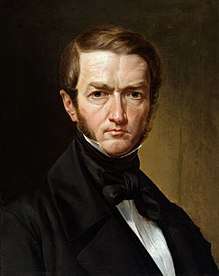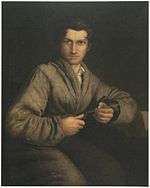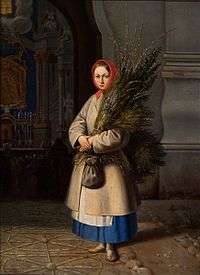Kanuty Rusiecki
Kanuty Rusiecki (Lithuanian: Kanutas Ruseckas; 10 February 1800 – 21 August 1860) was a Polish[1][2] and Lithuanian[3][4] painter. He authored the first Polish romantic theory of painting.[5]
Kanuty Rusiecki | |
|---|---|
 Self-portrait (1830s) | |
| Born | 10 February 1800 |
| Died | 2 September 1860 (aged 60) |
| Nationality | Polish / Lithuanian |
| Education | Vilnius Imperial University Faculty of Physics (from 1816), Vilnius Imperial University Faculty of Literature and Liberal Arts (switched to it in 1818), French Academy in Rome (from 1822) |
| Known for | Painting, drawing |
Notable work | Lithuanian Girl with Palm Sunday Fronds, Altar paintings for Vilnius Cathedral, Church of St. Theresa |
| Movement | Romanticism |
Biography

Rusiecki was born in Stebėkiai, near Vadokliai, Russian Empire (now Lithuania) into an impoverished noble Lithuanian family. His father was a magistrate. He is said to have displayed his artistic talent at an early age, making impromptu models in wax. In 1816, he began his studies at the University of Vilnius. Initially, he studied law and mathematics, but eventually followed his true interests and, in 1818, switched to the study of art, under the tutelage of Jan Rustem and Kazimierz Jelski.[6] During his stay at the University, he was a member of the Philomaths, a secret society of Polish students.
With letters of recommendation and his father's financial support (and following a secret marriage), he went to Paris and enrolled at the École nationale supérieure des Beaux-Arts from 1821 to 1822, studying with Guillaume Guillon-Lethière. He then spent a year at the Accademia di San Luca in Rome, where he worked with Vincenzo Camuccini and attended the sculpture workshop of Bertel Thorvaldsen.[6] He was one of the founders of the Polish artistic colony in Rome.[5][1] He served as the informal leader of the Polish-Lithuanian art community there and presented an exhibition of Polish Romantic painters. Between studies, he toured extensively, painting portraits and landscapes throughout Italy.
Beginning in 1831, he gave private drawing lessons in Vilnius. Three years later, he became a Professor at the "Wileński Instytut Szlachecki" (institute for the nobility) and taught there until his death.[6] In 1856, he joined with Wincenty Dmochowski and Kazimierz Jelski in an effort to create an independent art school. He painted altar pictures and restored frescoes in many small churches throughout Lithuania, as well as at the Vilnius Cathedral. He died in Vilnius.
Most of his canvases were in private collections that have been dispersed and are now difficult to trace. Although fairly numerous, all but a few of his known paintings are those that were left in his studio at the time of his death. They were preserved by his son Bolesław Rusiecki, who was also a painter, and later bequeathed to various museums in Poland, Lithuania and what is now Belarus.[7]
References
- Nitka, Maria (2013). "Rosyjscy i polscy malarze w Rzymie lat 20. XIX wieku – wspólne narodziny malarstwa akademickiego (Russian and Polish painters in Rome in the 1820s and at the beginning of the 1830s – the common birth of the XIX century academic art)". Sztuka Europy Wschodniej (Art of Eastern Europe) (in Polish). Polish Institute of World Art Studies. 1: 309, 311.
- Malinowski, Jerzy; Gavrash, Irina (2015). "Inspiration with Antiquity in Polish art around 1900s". Actual Problems of Theory and History of Art. Saint Petersburg State University. 5 (5): 698. doi:10.18688/aa155-8-76.
- Drėma Vladas, "Kanutas Ruseckas," 1996 m., Vilnius, 12 - 14 p.
- "Italija Lietuvos dailininkų gyvenime" (Lithuanian Artists Lives in Italy) Archived 2015-01-15 at the Wayback Machine by Marius Vyšniauskas (scroll down for Rusiecki)
- Malinowski, Jerzy (2002). "Editorial". Pamiętnik Sztuk Pięknych. Nicolaus Copernicus University (1): 5. ISSN 1730-0215.
- Timeline Archived 2015-02-02 at the Wayback Machine @ the Lietuvos Nacionalinė Martyno Mažvydo Biblioteka.
- Rusiecki and Wańkowicz by Beata Garnyte @ Nasza Gazeta.
External links
| Wikimedia Commons has media related to Kanuty Rusiecki. |
- "Italija Lietuvos dailininkų gyvenime" (Lithuanian Artists Lives in Italy) by Marius Vyšniauskas (scroll down for Rusiecki)
- Belarus: Official website: "Kanuty Rusiecki’s works to go on display at Mir Castle"
